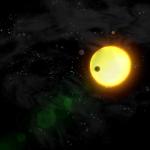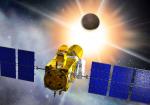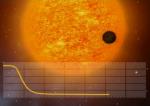- News / Thoughts
- Astronomy Guide
- On This Day
- Reviews
- Bookstore
COROT space mission
12/23/2006
o
O

Artist's view of exoplanet in front of a star. Image credit: ESA 2003. Illustration by AOES Medialab
Search for exoplanets, planets which circle around some other star then our Sun, started in 1995 with the discovery of first such planet, called 51 Pegasi b. Since then, more then 200 other exoplanets have been found, but because of Earths atmosphere, search has come close to the point where Earth based telescopes cannot keep up.
French space agency, CNES (Centre National d'Etudes Spatiales), together with ESA (European Space Agency) is soon launching COROT satellite for more precise search of exoplanets, and to study interiors of stars.
In the last decade, astronomers have reached another, almost insurmountable, milestone. They've started discovering planets around other stars, so called exoplanets. First one was found in 1995 in the constellation of Pegasus, and was called 51 Pegasi b. Discoverers were Michael Mayor and Didier Queloz using French observatory Observatoire de Haute-Provence. Soon the exoplanet search mania started, resulting in todays count of more then 200 of them.
o
O

Artist's view of exoplanet in front of a star. Image credit: ESA 2003. Illustration by AOES Medialab
There are numerous techniques for discovering exoplanets, but as the equipment got better, detecting of smaller planets or those with longer orbit around their star became possible (if the exoplanet is further away from their star, it seems smaller, and it's orbital period is longer).
Although first exoplanets were quite bigger then Jupiter, few of them were as small as 5.5 times the size of Earth. According to the current theory on planet formation, all planets that big are gaseous giants. The possibility to detect an Earth like planet, made primarily of metal and rocks, is almost grounding to a halt. To detect such small planets we need even higher precision telescopes, but all Earth based ones are nearing their capabilities because of our atmosphere getting in the way.
Few years before first exoplanet discovery, French space agency CNES (Centre National d'Etudes Spatiales) started to think about a project which would use improved technology aboard SOHO satellite, to study nature of stars.
SOHO satellite is, for more then a decade, studying our Sun with it's assortment of devices. One of them is studying ripples on its surface, made from sound waves which are generated inside our star in nuclear reactions. The sound cannot be heard, since almost perfect vacuum exists between us and the Sun, but by studying it's surface ripples and powerful starquakes, we can decipher the interior characteristics of a star. That procedure quite resembles seismology on Earth, but since it's studying stars it's called astroseismology.
o
O

Artist's view of COROT satellite. Image credit: CNES/D. Ducros
CNES's satellite, called COROT (COnvection and ROTation), has a mission to study 120 000 stars close to us, and with the above described technique, find out their nature, which we know very little about. It is possible to enhance our understanding of star interior, their life expectancy, and how much they differ among themselves. As a metering unit for comparing the data, we'll use the best know star, our Sun.
In 1999, COROT mission got into financial problems, and the mission was almost canceled. French CNES called its international partners to help them. Since ESA already had planned similar project called Eddington they've decided to join with CNES.
Eddington was also destined to study stars using astroseismology, but also to try to find exoplanets with the size, or even half the size, of the Earth. ESA's Eddington and CNES's COROT were similar enough that they could merge into one mission. The abbreviation COROT, got a new meaning - Convection Rotation and planetary Transits. ESA canceled it's Eddington project in 2003.
o
O

COROT satelitte will be able to observe two areas, each around 10° big. Image credit: CNES
The launch of COROT is scheduled for December 27, 2006. Satellite will be put in polar orbit around Earth. With it's primary mirror, sized 30cm, it'll scan two areas in the sky. First area will be towards galaxy center, and the other area is in the direction of Orion, exactly in the opposite direction of Milky Way. Each area will be scanned for 6 months, with mission lasting in total of around 2.5 years. After light from the Sun starts to scatter inside the telescope, satellite will rotate 180°, into previous area.
O

Planet transit in fron of a star. Image credit: CNES
From the telescope, the light will be guided to a two-part camera. First part is a photometer, device which is capable of detecting even slightest changes in light brightness. Star brightness change is caused by ripples on it's surface, and short lasting slight drop in intensity signifies that something has occulted the star, ie. an exoplanet. The other part of the camera is splitting the light into spectrum using a prism, and studies it. It'll detect the reasoning behind brightness change, since there are multiple possibilities for it. For example it can be something else then exoplanet, like occulting double star, where two stars are orbiting each other, occulting one another and thus diminishing the light brightness.
It is expected that the mission will find dozens of gaseous exoplanets and a number of rocky planets like Earth. Scientists hope that the data received will further our statistical count of exoplanets in nearby galactic neighborhood. It'll try to confirm various models of solar systems, and the theory of their creation. Astroseismology will find the interior of other stars, their life expectancy, their structure and the nature of nuclear reactions inside various types of stars. Possible information we'll get from that research are star composition, their age, and with it we can even advance our understanding of their real distance from us.
As already mentioned, ESA had Eddington project with was scheduled for 2008. In a way Eddington is part of decade long race for exoplanets because NASA also plans to launch their Kepler mission in 2008, which will also scout for exoplanets. European mission COROT, merged with Eddington project, thus becomes first satellite with such purpose. Although Kepler will have better technology, COROT has two-year advantage.
Beside this mission ESA, in her search for life around other stars, plans to launch Darwin project around 2013., which will be direct successor of COROT.
Links of interest: